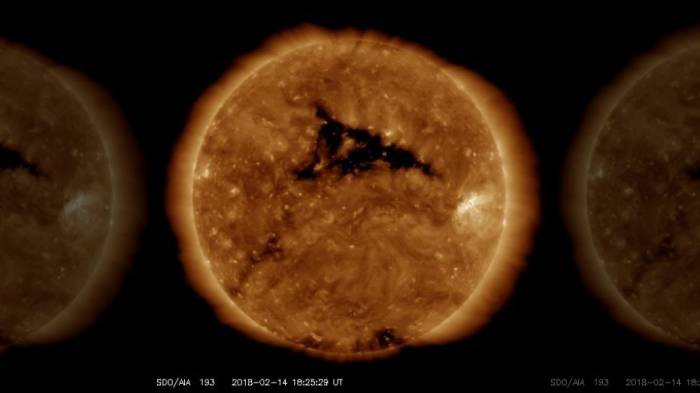NASA’s Solar Dynamics Observatory Satellite captured a solar flare on the Sun releasing a coronal mass ejection (CME) around 8:25 p.m. ET Sunday.
“[CMEs] are huge explosions of magnetic field and plasma from the Sun’s corona,” the Space Weather Prediction Center (SWPC) explained in a post online. “When CMEs impact the Earth’s magnetosphere, they are responsible for geomagnetic storms and enhanced aurora.”
The National Oceanic and Atmospheric Administration (NOA) issued a G1 (minor) geomagnetic storm watch for Thursday.
Here’s what you need to know about solar storms — and how they can impact the Earth — before one hits the planet on Thursday.
What is a solar flare?
Magnetic storms on the surface of the Sun can cause what is known as “solar flares.”
“A solar flare is an intense burst of radiation coming from the release of magnetic energy associated with sunspots,” according to NASA. “Flares are our solar system’s largest explosive events.”
If the storm is strong enough it will cause a CME, which is what happened in this case.
“The strongest flares are almost always correlated with coronal mass ejections,” NASA points out.
How do solar storms impact Earth?
There are a variety of things that could potentially happen.
The storm could increase the brightness and visibility of auroras, also known as the Southern or Northern Lights. ”Aurora may be visible at high latitudes, i.e., northern tier of the U.S. such as northern Michigan and Maine,” the NOAA said in an alert Wednesday.
Regions may notice weak power grid fluctuations, though that’s unlikely to happen in this “minor” storm.
Minor damage Earth-orbiting satellites,”especially those in high, geosynchronous orbits” could occur, NASA says.
High frequency radio waves could be “degraded,” NASA adds.
A NASA study warns solar storms could confuse the internal compasses of marine mammals, causing an increase in strandings on beaches.
“Geomagnetic storms are more disruptive now than in the past because of our greater dependence on technical systems that can be affected by electric currents and energetic particles high in the Earth’s magnetosphere,” NASA explains.
Should we be worried?
Not really. This particular storm is catergorized as minor, but that doesn't mean it can't impact the Earth.
Solar storms are actually pretty common. On average, solar activity increases every 11 years, NASA scientists say, and there's an uptick in solar flares during these cycles.
Fortunately, Earth’s atmosphere and magnetic field keep us well-protected.
“Some people worry that a gigantic ‘killer solar flare’ could hurl enough energy to destroy Earth, but this is not actually possible,” NASA explained in a 2013 article online. "Even at their worst, the sun's flares are not physically capable of destroying Earth."
For years, people have lived through solar storms without harm.
"In general, the physical danger is low and controllable," CNET reported, citing the NOAA, after a solar storm struck Earth in March 2012. "The biological hazard inherent in solar and geomagnetic storms comes from the exposure to radiation, which is mainly a concern for astronauts and people flying at high altitudes."
The "explosive heat" from solar flares can’t directly hit our planet, but the flares can, however, cause plenty of disruptions (like the ones listed above).
More about: #Solar-Storm
















































